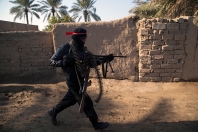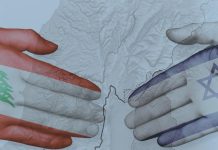Kataib al-Imam Ali: Portrait of an Iraqi Shiite Militant Group Fighting ISIS
Matthew Levitt and Phillip Smyth /Washington Institute
January 5, 2015
Although Iran’s proxies are fighting ISIS in parallel with the U.S.-led effort, their actions and radical Shiite agendas are diametrically opposed to the goal of building inclusive governments and societies in Iraq and Syria.
Over fifty Shiite militia organizations in Syria and Iraq currently claim to be training and fighting against the “Islamic State”/ISIS. Many are armed branches of established political parties or follow individual clerics. Some are fronts for established groups, while other newer groups are developing their own profile and presence. In addition, new militias have been established along the lines of al-Hashd al-Shabi (The Popular Mobilization) and are growing in size and influence. Although many of these groups are indeed countering the ISIS advance, a number are linked to extremist anti-American leaders and factions, particularly Kataib al-Imam Ali (the Imam Ali Brigades). Such militias present further threats to regional security and U.S. interests in the Middle East.
KATAIB AL-IMAM ALI
Announced in late June as the armed wing of the newly created Harakat al-Iraq al-Islamiyah (The Movement of the Islamic Iraq), Kataib al-Imam Ali burst onto the scene with uniformed and well-armed members. It has been quite active in Amerli, Tuz, and Diyala fighting alongside other Iraqi Shiite militias, all of them Iranian proxies. In Salah al-Din province, fighters from the group posed in videos with the severed heads of their slain enemies. And in late December, the group even set about training Christians for a subgroup called Kataib Rouh Allah Issa Ibn Miriam (The Brigade of the Spirit of God Jesus Son of Mary).
Shebl al-Zaidi, the secretary-general of Kataib al-Imam Ali, was once a noted figure in Muqtada al-Sadr’s Mahdi Army — and reportedly one of its more vicious sectarian leaders. He was jailed during the U.S. occupation of Iraq, only to be released by the Iraqi government in 2010. Last summer, as Kataib al-Imam Ali became more established after its June debut, Zaidi was photographed with Qasem Soleimani, commander of Iran’s Islamic Revolutionary Guard Corps-Qods Force. The group also appears to have strong links with the Iraqi government; in August and September, it published pictures of Zaidi riding in an Iraqi army helicopter and one of the militia’s field commanders, Abu Azrael, manning a different helicopter’s machine gun.
However, another IRGC-linked leader, Abu Mahdi al-Muhandis, appears to head Kataib al-Imam Ali’s operations and expansion efforts, and his presence explains the group’s meteoric growth. Wearing patches belonging to the militia and shown in a number of photos embracing Zaidi, Muhandis is a commander with considerable experience in building new extremist Shiite groups — and a long history of attacks against Americans and American interests.
MUHANDIS AND THE QODS FORCE
Iraqi Shiite extremists in general, and Muhandis in particular, have featured prominently in Iran’s arsenal of regional proxies for many years. Some of the most proactive Iraqi figures who have worked with Tehran since 2003 began as Iranian proxies some twenty years earlier.
Muhandis (a.k.a. Jamal Jaafar Muhammad Ali) first came to prominence as one of the Iraqi Dawa Party terrorists who partnered with Hezbollah to carry out the 1983 embassy bombings in Kuwait and the 1985 assassination attempt on the Kuwaiti emir. Convicted in absentia for his role in those attacks, he went on to lead the Badr Corps, the militant wing of the Supreme Council for the Islamic Revolution in Iraq (SCIRI). The Badr Corps not only fought alongside Iranian forces in the Iran-Iraq War, it also engaged in acts of sabotage and terrorism targeting Saddam Hussein’s regime. Muhandis worked directly with the Qods Force and other militant Iraqi Shiites who opposed Saddam.
According to Iraqi documents captured by coalition forces, his chief of staff in the Badr Corps was Hadi al-Ameri, who would go on to head the Badr Organization (so renamed in an attempt to rebrand itself as a political party) and serve as a parliamentarian after Saddam’s overthrow. During the 1990s, Muhandis was succeeded by Abu Mustafa al-Sheibani as commander of the Badr Corps. By this point, Muhandis had Iranian citizenship, and he became an advisor to Qods Force commander Soleimani. Muhandis and Sheibani even lived in the same IRGC compound for some time, and together with Ameri, they went on to become key Shiite militant leaders in the post-2003 invasion period. In 2008, a report published by West Point’s Combating Terrorism Center concluded that “some of Iraq’s most wanted Shi’a insurgents share Badr Corps lineage with Iraqi politicians operating openly in Baghdad.”
Today, links persist between the Badr Organization and newly established militias. For example, one former member — parliamentarian and militia leader Sheikh Adnan al-Shahmani — now heads the group Tayyar al-Rasouli. Kataib al-Imam Ali appears to have similar links; in September, it even produced martyrdom posters commemorating fallen Badr Organization commander Abu Zahra al-Ghafari. Such links may explain how Kataib al-Imam Ali grew so quickly and already included a sizeable number of what appeared to be trained fighters.
THE KATAIB HEZBOLLAH MODEL
Even as it supported political allies such as SCIRI and Muqtada al-Sadr, Iran also backed their respective military wings, the Badr Corps and Mahdi Army. When the renamed Badr Organization entered politics, Iran encouraged extremists to splinter off and form their own militant groups, echoing its past encouragement of Shiite radicals to split from Lebanon’s Amal Party to form Hezbollah. Accordingly, Sheibani and Muhandis dropped their associations with Badr and went on to found terrorist groups that played central roles in Iran’s proxy networks.
In 2007, Muhandis formed Kataib Hezbollah (the Hezbollah Brigades, or KH). Given his longtime ties to Dawa and the Qods Force, it was no surprise when his new group began receiving more sophisticated training and sensitive equipment than all other Iranian proxies in Iraq. Although KH was technically distinct from its namesake in Lebanon, it would develop especially close ties with Unit 3800, the Lebanese Hezbollah entity dedicated to arming and training Iraqi Shiite militant groups.
In July 2009, the U.S. Treasury Department blacklisted Muhandis and KH for having “committed, directed, supported, or posed a significant risk of committing acts of violence against Coalition and Iraqi Security Forces.” Both were designated under Executive Order 13438, which targeted insurgent and militia groups and their supporters; KH was also added to the State Department’s Foreign Terrorist Organizations list.
According to information released at the time of these designations, Muhandis was employing Lebanese Hezbollah instructors by early 2007 to train KH and other Shiite militant special groups in using guerrilla warfare, explosives, and various weapons (including missiles, mortars, and sniper rifles) against coalition forces. He also led smuggling networks that moved ammunition and weapons (e.g., explosively formed penetrators and sniper rifles) from Iran to Iraq for these militias. In addition, he provided other forms of logistical support for attacks against Iraqi and coalition forces, such as facilitating the movement of local Shiite militia members.
Under Muhandis, KH forces were among the first Iranian proxies to join the Syria war as well. In March 2013, after a number of funerals were held for Lebanese Hezbollah members killed in Syria, KH became the second group to declare it had lost fighters there. The group claims to have lost around forty fighters in total, going so far as to build a new martyrs area in Najaf’s Wadi al-Salam cemetery. It has also helped build Syria-based Shiite militias such as Liwa Abu Fadl al-Abbas (LAFA) and Iraq-based groups such as Harakat Hezbollah al-Nujaba.
Fighting in Syria did not distract KH from last year’s upsurge in violence in Iraq, however. As with other Iranian proxies, Kataib Hezbollah was several steps ahead of mainstream calls from Iraq’s government and traditional clerical apparatus for the mobilization of Iraqi Shiites against ISIS. In April, a new militia — Saraya al-Difa al-Shabi — issued calls for volunteers. And in early May, KH claimed the loss of two fighters in Anbar, its first fatalities in the fight against ISIS. Both KH and Saraya al-Difa al-Shabi have since been operating across central Iraq, from Anbar to Samarra to Diyala.
WHY SO MANY MILITIAS?
If Muhandis’s hand in the development of KH and Kataib al-Imam Ali proves one thing, it is that Iran’s extremist proxies assume a variety of forms and functions, with some taking on lives of their own as they expand in size or enter the Iraqi political fray.
Unlike other Iranian Shiite radical groups, KH has not entered politics; instead, it has chosen to project power by remaining in Iraq as an armed group. Other groups have retained their militia structures but embedded them into Iraqi state apparatuses.
For its part, Kataib al-Imam Ali may be seeking a political role in the future by claiming ties to a parent party. At present, its influence has spread from southern Iraq, through Baghdad, to most of the frontline ISIS hotspots, as the militia trains new combatants and fulfills Iran’s strategic goal of crafting more “Islamic Resistance”-style organizations.
The creation of new militias may appear counterintuitive when there are already many established groups that could be further built up. Yet new groups enable Tehran to diversify its political and military portfolio in Iraq. The wide range of these organizations also serves as a way to slowly impart and legitimize its ideology and power within Iraq. This phenomenon is slowly happening in Syria as well.
For Western and regional policymakers, the large number of groups, connections, and overlapping areas of influence creates further confusion, giving Iran and its proxies further room for plausible deniability if the need arises. The situation also creates an illusion of choice and independence for those joining or supporting these radical Shiite militias and parties.
Most important, it is incorrect to suggest that these groups are limited to combating ISIS or operating in Syria or Iraq alone. Tehran and its proxies are primarily focused on those theaters at the moment, but radical Shiite militias are already beginning to behave like regional actors with larger goals. For example, KH, Kataib al-Imam Ali, and similar groups have repeatedly threatened Saudi Arabia over the death sentence handed down to Shiite cleric Nimr al-Nimr, who was charged with sedition and related offenses in October. Although these radical militias are fighting ISIS in parallel with the U.S.-led effort, their actions and sectarian agendas are separate from the coalition’s and run counter to the goal of building inclusive governments and societies in Iraq and Syria. Indeed, Kataib al-Imam Ali and its ilk present long-term threats to regional stability and U.S. interests. Even as Washington focuses on fighting ISIS, it would do well to prepare now for the day when radical, Iran-linked Shiite militias turn more actively against America’s interests and allies.
**Matthew Levitt is the Fromer-Wexler Fellow and director of the Stein Program on Counterterrorism and Intelligence at The Washington Institute. Phillip Smyth, a researcher at the University of Maryland, is author of the blog Hizballah Cavalcade and the upcoming Institute monograph The Shiite Jihad in Syria and Its Regional Effects.





















